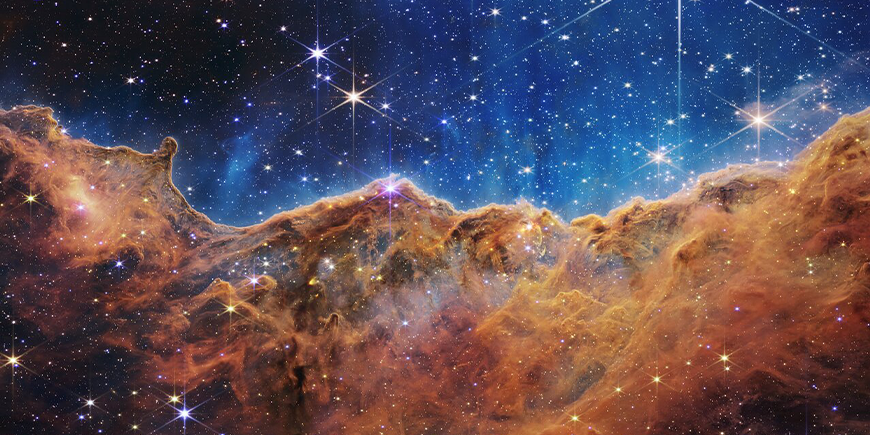Highly anticipated observations from the Webb Space Telescope reveal a universe as never before seen and hint at a treasure trove of discoveries to come.
The James Webb Space Telescope, a collaboration between NASA, the European Space Agency (ESA) and the Canadian Space Agency (CSA), has made history in the world of space exploration with its first “full-colour” images of the Universe. These images provide the deepest, highest-resolution views ever captured.
The instrument
The James Webb Space Telescope (JWST) is an infrared astronomy space telescope that was launched into orbit on 25 December 2021 aboard an Ariane 5 rocket from the European Spaceport in French Guiana, South America. It carried the hopes and dreams of many enthusiasts, scientists and astronomers.
It took several months to get Webb up and running, during which time its mirrors were meticulously aligned and its instruments were calibrated for the space environment and prepared for science operations.
The James Webb Space Telescope is one of the most powerful tools mankind has ever developed for exploring space. Its extraordinary technology allows it to see beyond the visible spectrum, detecting objects that emit radiation at wavelengths above 700 nm (where 1 nm is a billionth of a metre).
This type of telescope is mainly used in space, where such radiation is not disturbed by most cosmic or interstellar dust, allowing us to observe the Universe almost back to its dawn, provide images of distant planets, and even search for possible chemical forms of life.
After more than 10 years of delays, construction and logistical problems, constant setbacks and an investment of more than $11 billion, expectations for JWST’s capabilities were high. Today, we can confidently say that these expectations have been far exceeded.
A hidden Universe
Webb’s first observations tell the story of the hidden Universe through every phase of cosmic history – from neighbouring exoplanets to the most distant observable galaxies in the early Universe, to everything in between.
“Today, we present humanity with a groundbreaking new view of the cosmos from the James Webb Space Telescope – a view the world has never seen before,” said NASA Administrator Bill Nelson. “These images, including the deepest infrared view of our Universe that has ever been taken, show us how Webb will help to uncover the answers to questions we don’t even yet know to ask; questions that will help us better understand our universe and humanity’s place within it.
These “full-colour” images complement the preview image presented by US President Joe Biden at the White House on 11 July, showing the galaxy cluster SMACS 0723, captured in just 12.5 hours.
This observation is called a “deep field“, essentially a long exposure view of deep space, capable of detecting galaxies and celestial bodies near the edge of the Universe. The individual dots in the image are actually thousands of galaxies, some as far away as 13 billion light-years, at the edge of time. The immense gravitational lensing effect, never seen before in an infrared image (converted to visible colours and spectrum for presentation), is also remarkable. The star-like objects with six-armed diffraction spikes are stars from our galaxy, randomly positioned in Webb’s line of sight.
“This image,” says the European Space Agency website, “only scratches the surface of Webb’s ability to study deep fields and trace galaxies back to the dawn of cosmic time”.

Other observations
The second observation concerns a hot and puffy exoplanet identified as WASP-96b, where the presence of water in its atmosphere has been detected for the first time.

The image of NGC 3132, known as the Southern Ring Nebula, a patch of ultraviolet-illuminated space some 2,500 light-years away, is particularly striking. Here, Webb’s powerful infrared eyes reveal for the first time a second dying star: this spectacle is due to the collapse of a white dwarf and the subsequent release of the star’s outer layers, which could one day become a new star or a new planet.

Also spectacular is the image of Stephan’s Quintet, a compact group of five galaxies in the constellation Pegasus, whose details can only be seen thanks to Webb’s powerful infrared instruments. Scientists can now see with unprecedented resolution how interacting galaxies trigger star formation in each other, and how the gas in these galaxies is disturbed.

The latest image released so far, which has already become iconic, is of the Carina Nebula, which shows one of the most extensive and luminous assemblages of ionised gas in the sky. This nebula is about 7,500 light-years away and lies in a region known as the “Cosmic Cliffs”, as a veritable ocean of stars serves as its backdrop. By observing this region, Webb can see newly forming stars and study the gas and dust that created them.

A new window on the Universe
“Scientifically, the data open a new window on an era in the history of the Universe that has not yet been explored,” says Adriano Fontana, head of the National Department for Optical and Infrared Astronomy at the National Institute for Astrophysics (Inaf).
The capabilities of the James Webb Space Telescope will allow us to observe the universe almost back to its beginnings, opening up a world of infinite possibilities for its use. It could solve many open cosmological questions, both about deep space and about space closer to us. Scientists will use Webb to study planets and other bodies in our solar system to determine their origin and evolution.


